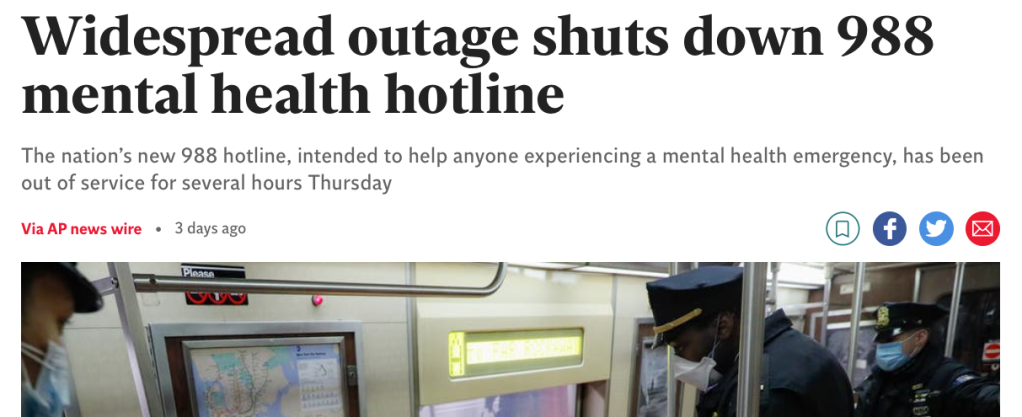This blog usually has fun decoding the confusions of agenda and language that international anglophone news throws up – human “coyotes”, angry cassowaries chasing “blokes”, and so on. But this ambiguity is potentially more serious.
This summer, the US launched a new suicide prevention hotline number, 988. There have recently been technical problems with it that forced it offline for a period. For some reason in the past few days – perhaps as a result of this news – some British Twitter users started copy-pasting and retweeting boilerplate text to raise awareness of the number as if it were a service in the UK, even though, of course, it isn’t, and that number here connects to nothing.
The confusion does seem to have spread,
and to have reached the point where where Mind, the prominent British mental health charity, was deploying its social media team to refute it:
Now Joe McNally at Horny Handed Subs of Toil suggests that a news story on the Independent website in the UK about 988’s technical problems may have fuelled some of the confusion.

The Independent is not one of the British news organisations determined to break into the US market – it’s UK-focused – and yet this story that it published last week seems to be a straight Associated Press wire story for an American audience. The headline, the opening paragraphs and even the photo are identical to the original version on the AP site.
As McNally says in his post, “for obvious reasons, sharing false information about emergency mental health services has enormous potential to cause serious harm”. And he rightly points out that here,
“nobody thought to make it clear at any point in the copy that this is an American story. It mentions a US health agency and a US health official but it’s full of references to ‘national’ services and ‘the nation’ without ever once explicitly stating *what that nation is*”.
He also says that several British people linked to this article to defend the information they had shared, because it’s so ambiguous about location. Arriving at the story almost 48 hours late, and with the rebuttal effort in full swing, I can’t now find any tweets that explicitly do this (although it may have happened on other social media). But even without a social media kerfuffle, the potential for this article to confuse, when presented on a UK site without any context, is clear. (Look at the bald headline in the screenshot above, on a site belonging to a British newspaper with not much of an international profile. Where would you conclude this hotline service might be based?)
As you read it closely, you see clues: 911, which is mentioned as “the emergency line”, is of course not the UK’s emergency line. Britain has no “Department of Health and Human Services”. The number was out of service “for several hours Thursday”, not “several hours on Thursday”. “Counselors” is given with one L, not two. But these are things that an editor would notice, not necessarily a member of the public.
At the Tribune, we have a lookup table for crisis hotline numbers in our three markets – the UK, the US and Australia – and add them as footnotes to relevant stories according to which audience the piece is intended for. In the UK, the number we give is 116 123, for the Samaritans. But as we have discussed many times on the blog, content intended for one market has a way of leaking across the website and being found by readers abroad.
That’s why the Tribune’s audience and SEO team, despite their rapacious appetite for clicks and sensation, still insist on us making clear in every headline or standfirst which country the news we report is taking place in. A footnote at the end is all very well, but the word “American” in the Independent’s standfirst here would have killed off the confusion at source.
Observing from outside, the article gives every impression of having been auto-launched without editorial intervention. However, if you read it word for word against the version on the AP site, there are some differences. This paragraph appears in the AP version but not in the Indy version,
“Veterans who are looking to reach the helpline can call the Veterans Crisis Line directly at 877-267-6030. The outage is also affecting the Substance Abuse and Mental Health Services Administration’s Disaster Distress Helpline.”
and this additional information appears at the end of the agency’s version too:
“In a statement on its website, the company said it is ‘experiencing an incident that is impacting production across numerous systems’ and is ‘working diligently to restore service.’”
It’s not entirely clear why this is so. If these are the interventions of an editor at the Indy, then it’s worrying that they made those emendations but not others that would have clarified the story fully. (Also, why would anyone delete the contractor’s statement at the end?) It is perhaps more likely that these are additions from a later write-through by AP reporters, and that the Indy fetched the story for its site before they were filed; obviously the AP’s own site will always have the fullest, latest version.
If the latter is the case, then the article would indeed seem to have published with minimal human intervention, which calls to mind the complaint voiced for years by the old Testy Copy Editors website: “Hundreds of newspapers run AP completely unedited!” If that was a problem in the old days of American print, then it must be even more so now that hundreds of websites – and not all of them in the US – are running AP unedited too.
h/t: Joe McNally

Leave a comment